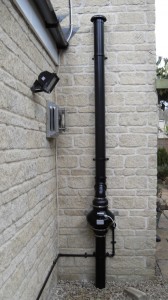Have you had a radon sump installed at your property to reduce high radon levels? Maybe you’ve just bought a property whe re there is an existing sump. We are often contacted by homeowners and building managers with one question: “How do I know if my radon sump is working?”
re there is an existing sump. We are often contacted by homeowners and building managers with one question: “How do I know if my radon sump is working?”
There are two parts to this question; firstly is the system operational (i.e. is the fan running) and secondly if it is running, is the system effectively reducing radon levels within the building.
A simple way to establish whether the system is operational is to hold a piece of paper near the exhaust and check whether it moves, indicating airflow is passing through the pipework. You may also be able to hear the air movement (and with some models, the fan itself) and feel slight vibrations in the pipework.
A more reliable method is to use an alarm to alert you if the fan stops running. The battery-operated RadonAway Air Flow Alarm is attached to the sump pipework and will activate with a visual and audible alarm if for any reason the airflow through the pipework stops. At propertECO we include these alarms as standard in our radon sump system designs as it is important that you are alerted if the radon mitigation system is not functioning. If you have an existing sump system and would like to add the reassurance of an alarm, the component is simple to fit and can be purchased for £85.00 +VAT from our online store, www.radonshop.co.uk.
Once you have confirmed that the radon sump system is in good working order mechanically, it is important to check that it is fulfilling its intended purpose of reducing radon levels within the building. To do this, a radon test should be carried out. Testing can be undertaken using inexpensive passive radon detectors that are left in place for a period of time before being posted back to a laboratory for analysis, or with a digital monitor which provides an on-screen result (this is not an instant measurement and must take place over a minimum of a week).
propertECO includes the provision of a radon test kit in all quotations for radon mitigation to enable post-work testing to be carried out. We recommend this commences one month after completion of the works. Repeat testing should be carried out at least once every two years. If any other works to the property are carried out such as the installation of new double glazing or an extension being added, a radon test should be conducted as this can impact upon the performance of a sump system.
Radon is an issue that must be managed over the long term and should not be considered a ‘fix and forget’ scenario as this could inadvertently leave you exposed to elevated levels of radiation. Having spent money installing a radon remediation system it pays to ensure that it is working.

